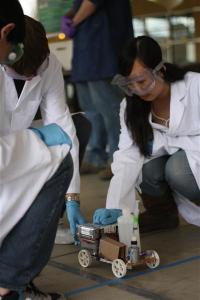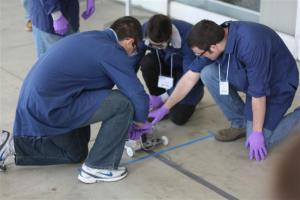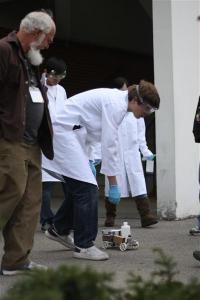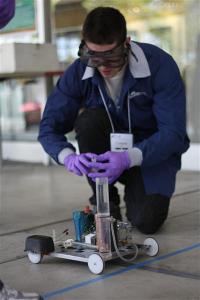
Sometimes, it just pays to pump iron. Chemical engineering students from the University of Washington (UW) and the University of Idaho (UI) competed in the ChemE-car competition at the AIChE Pacific Northwest Regional Student Conference in Moscow, ID, on Saturday, April 28, 2012. The contest is difficult, because the rules say you have to build a car from scratch (you can use pre-fabricated individual components) and not only make it go using chemistry, but also stop it within a specified distance carrying a specified load (between 0 and 500 ml of water) using chemistry, too. One tricky part is that the exact load to be carried is not revealed to the contestants until 2 hours before the competition. Each team gets two attempts before the winner is declared. The distance specified at this competition was 52 feet and the specified load was 450 ml of water. This was close to the minimum distance and maximum load in terms of the ranges allowed. The two teams both made custom-built cars whose stopping mechanism was a clever reaction known as the "iodine clock." The timer starts ticking down in the clock when hydrogen peroxide and sulfuric acid are mixed with a second solution containing potassium iodide, sodium thiosulfate, and starch. A fast and a slow reaction proceed simultaneously, ultimately culminating in the consumption of thiosulfate and a color change of the solution to dark blue as a starch-iodine complex develops. A light-operated switch that is positioned to keep an eye on the reaction then shuts off the car's motor, which was powering the car.

But this was where the similarities between the two teams ended. The UW team - William O'Neill, Alex Stark, Alex Kon, Kelly Wang, and Kenneth Davidson, under the faculty sponsorship of UW chemical engineering professor Dr. Daniel T. Schwartz - powered its car using an exothermic magnesium oxidation reaction, which made use of iron as a catalyst to produce the heat necessary to drive a set of 6 thermo-electric generators, thus providing electricity to the motor.

The UW team's first run didn't properly account for the cooler-than-expected outdoor temperature, so the iodine clock reaction was too slow and the car drove completely haywire and out of bounds, with its creators chasing it off the edge of its concrete slab. The UI team - Frank Ramirez, Brennett Rodseth, Kirk Riedner, Jared Reynolds, Darby Hoss, and Conner Hill, under the faculty sponsorship of UI chemical engineering professor Dr. David Drown - powered its car using a hydrogen fuel cell reaction, which converts hydrogen and oxygen to water and electricity. The UI team used a six-stack fuel cell design to generate more voltage than a typical single cell would.

The UI team's car got accolades for more scientific pizazz but, unfortunately, it also had less punch. Their first run had the opposite problem of the UW's first run - the car only meandered forward a few inches. While it was clear how the UW team adjusted for its second run (the iodine clock was allowed to run longer before engaging the motor), it wasn't clear what the UI team did to improve - but both teams fared dramatically better on the second try. The UW car made it to within approximately 8 feet of the track's end before calculatedly shutting off, while the UI car scooted a few yards forward from the start line in a suspenseful go-slow-go-stop grand prix, then ultimately stalling for an honorable second place. Fun was had by all at this event. Videos of parts of the competition are included below: start your Chemgines!

